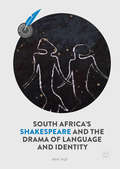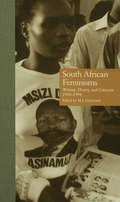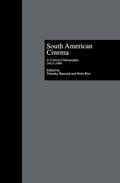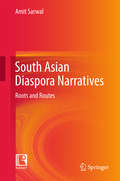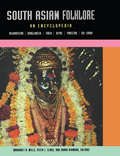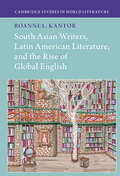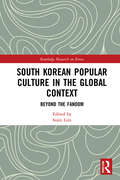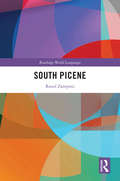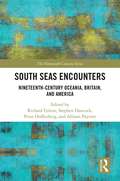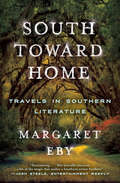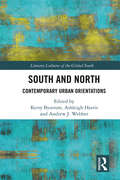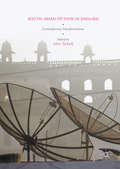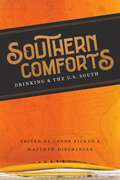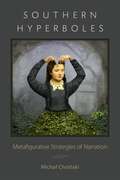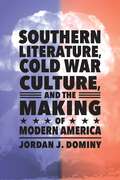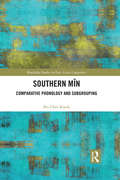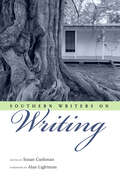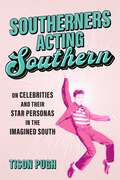- Table View
- List View
South Africa's Shakespeare and the Drama of Language and Identity (Global Shakespeares)
by Adele SeeffThis volume considers the linguistic complexities associated with Shakespeare’s presence in South Africa from 1801 to early twentieth-first century televisual updatings of the texts as a means of exploring individual and collective forms of identity. A case study approach demonstrates how Shakespeare’s texts are available for ideologically driven linguistic programs. Seeff introduces the African Theatre, Cape Town, in 1801, multilingual site of the first recorded performance of a Shakespeare play in Southern Africa where rival, amateur theatrical groups performed in turn, in English, Dutch, German, and French. Chapter 3 offers three vectors of a broadening Shakespeare diaspora in English, Afrikaans, and Setswana in the second half of the nineteenth century. Chapter 4 analyses André Brink’s Kinkels innie Kabel, a transposition of Shakespeare’s The Comedy of Errors into Kaaps, as a radical critique of apartheid’s obsession with linguistic and ethnic purity. Chapter 5 investigates John Kani’s performance of Othello as a Xhosa warrior chief with access to the ancient tradition of Xhosa storytellers. Shakespeare in Mzansi, a televisual miniseries uses black actors, vernacular languages, and local settings to Africanize Macbeth and reclaim a cross-cultural, multilingualism. An Afterword assesses the future of Shakespeare in a post-rainbow, decolonizing South Africa. Global Sha Any reader interested in Shakespeare Studies, global Shakespeare, Shakespeare in performance, Shakespeare and appropriation, Shakespeare and language, Literacy Studies, race, and South African cultural history will be drawn to this book.
South African Autobiography as Subjective History: Making Concessions to the Past (African Histories and Modernities)
by Lena EnglundThis book examines 21st-century South African autobiographical writing that addresses the nation’s socio-political realities, both past and present. The texts in focus represent and depict a South Africa caught in the midst of contradictory and competing images of the ‘Rainbow Nation’. Arguing that recent memoirs question and criticize the illusion of a united nation, the study shows how these texts reveal the flaws and shortcomings not only of the apartheid past but of contemporary South Africa. It encompasses a broad range of autobiographical works, largely published since 2009, that engage with South Africa’s past, present and future. At its centre is the quest for space and belonging, and this book investigates who can comfortably ‘belong’ in South Africa in its post-apartheid, post-Truth and Reconciliation, post-Mbkei and post-Zuma state.
South African Essays on 'Universal' Shakespeare
by Chris ThurmanSouth African Essays on ’Universal’ Shakespeare collects new scholarship and extant (but previously unpublished) material, reflecting the changing nature of Shakespeare studies across various ’generation gaps’. Each essay, in exploring the nuances of Shakespearean production and reception across time and space, is inflected by a South African connection. In some cases, this is simply because of the author’s nationality or institutional affiliation; in others, there is a direct engagement with what Shakespeare means, or has meant, in South Africa. By investigating the universality of Shakespeare from both implicitly and explicitly ’southern’ perspectives, the book presents new possibilities for considering (and reassessing) shifting manifestations of Shakespeare’s work in major Shakespearean ’centres’ such as Britain and the United States, as well as across the global North and South.
South African Feminisms: Writing, Theory, and Criticism,l990-l994 (Gender and Genre in Literature #Vol. 5)
by M. J. DaymondThis is the first collection of feminist critical essays by and about women in South Africa to appear outside of that country. Many of the pieces were written after February 1990, when President de Klerk lifted the ban on black political organizations. The recognition that a just society cannot be achieved without freedom from gender oppression as well as racial oppression informs these essays and has a direct bearing on the creation of a new society in South Africa.
South American Cinema: A Critical Filmography, l915-l994 (Historical Dictionaries Of Literature And The Arts Ser.)
by Timothy Barnard Peter RistFirst Published in 1996. This text looks at the cinema from the countries of Argentina, Brazil, Canada, Chile, Colombia, Cuba, United States, Uruguay and Venezuela. Presented by country and date order it includes the silent black and white Gaucho films of 1915 to the colour films coming out of Venezuela in 1991. Each entry provides a summary of the film content, its context, production and significance in the genre. It includes an index and glossary of Brazilian (Portuguese or African) Terms and film terms.
South Asian Diaspora Narratives
by Amit SarwalSome happy occasions, like the 1995 Commonwealth Writers' Prize for Best Book to Bangladeshi-Australian author Adib Khan, the 2008 Man Booker Prize to Indian born Australian writer Arvinda Adiga, and the 2013 Australian Prime Minister's Literary Award for Fiction to Sri Lankan-Australian author Michele de Krester, have boosted the self-confidence of South Asian-Australian writers in Australia. South Asian diasporic communities have also been the focus for relatively small, but constantly growing, studies by anthropologists and sociologists on the interrelation of gender, race, ethnicity and migration in Australia. The terms "Labels" and "Locations" capture numerous aspects that contribute in the making of a diasporic consciousness. This book critically examines the issues of identity, gender, family, class and caste, expressed in the short narratives of South Asian diaspora writers based in Australia. Taking an interdisciplinary approach--from literary, cultural, historical, anthropological, and sociological studies--this book engages chiefly with the oeuvre of postcolonial writers and academics, namely: Mena Abdullah, Adib Khan, Yasmine Gooneratne, Michelle De Kretser, Chandani Lokuge, Chitra Fernando, Satendra Nandan, Suneeta Peres da Costa, Hanifa Deen, Christopher Cyrill, Suvendrini Perera, Sunil Govinnage, Brij V. Lal, Sunil Badami, Glenn D'Cruz, Chris Raja, Manik Datar, David De Vos, Rashmere Bhatti, Kirpal Singh Chauli, Sujhatha Fernandes, Neelam Maharaj, Sushie Narayan, Madu Pasipanodya, Shrishti Sharma, Beryl T. Mitchell, and Sunitha. This book will, by calling upon the works of this much-neglected South Asian diaspora group, fill a lacuna in the broader critical rubric of diaspora studies.
South Asian Folklore: An Encyclopedia
by Margaret A. MillsWith 600 signed, alphabetically organized articles covering the entirety of folklore in South Asia, this new resource includes countries and regions, ethnic groups, religious concepts and practices, artistic genres, holidays and traditions, and many other concepts. A preface introduces the material, while a comprehensive index, cross-references, and black and white illustrations round out the work. The focus on south Asia includes Afghanistan, Bangladesh, India, Pakistan, and Sri Lanka, with short survey articles on Tibet, Bhutan, Sikkim, and various diaspora communities. This unique reference will be invaluable for collections serving students, scholars, and the general public.
South Asian Writers, Latin American Literature, and the Rise of Global English (Cambridge Studies in World Literature)
by Roanne KantorEver since T.B. Macaulay leveled the accusation in 1835 that 'a single shelf of a good European library was worth the whole native literature of India,' South Asian literature has served as the imagined battleground between local linguistic multiplicity and a rapidly globalizing English. In response to this endless polemic, Indian and Pakistani writers set out in another direction altogether. They made an unexpected journey to Latin America. The cohort of authors that moved between these regions include Latin-American Nobel laureates Pablo Neruda and Octavio Paz; Booker Prize notables Salman Rushdie, Anita Desai, Mohammed Hanif, and Mohsin Hamid. In their explorations of this new geographic connection, Roanne Kantor claims that they formed the vanguard of a new, multilingual world literary order. Their encounters with Latin America fundamentally shaped the way in which literature written in English from South Asia exploded into popularity from the 1980s until the mid-2000s, enabling its global visibility.
South Carolina PASS Coach, Social Studies (Grade #5)
by CoachThis book provides instruction and practice with all the important skills you need to know, and gives you practice answering the kinds of questions you will see on your state's test. The Coach book is organized into chapters and lessons, and includes a Pretest and Posttest. Before you begin the first chapter, your teacher may want you to take the Pretest, which will help you identify skill areas that need improvement. Once you and your teacher have identified those skills, you can select the corresponding skills lessons and start with those. Or, you can begin with the first chapter of the book and work through to the end. After you have finished all the lessons in the book, you can take the Posttest to see how much you've improved. And even if you did well on the Pretest, you'll probably do better on the Posttest because practice makes perfect!
South Korean Popular Culture in the Global Context: Beyond the Fandom (Routledge Research on Korea)
by Sojin LimThis book explores the recent landscape of Korean popular culture, including celebrity diplomacy, political activism, and inter-Korean relations in the era of ‘ontact’, with a special focus on K-pop and K-drama. Utilising the interdisciplinary approach, along with theoretical accounts, it redefines popular culture and its true power – beyond soft power – including discussions of how the pandemic and the use of online platforms have coincidently or effectively influenced recent phenomena surrounding Korean popular culture. It reveals both the possibilities and pitfalls of Hallyu diplomacy and the UN’s celebrity diplomacy more broadly, and highlights how, through the mobilisation of a large internet fanbase, the modern K-pop ‘standom’ can influence political discourse. The book also features an examination of the political significance of the K-drama through which it highlights the potential of popular media to impact inter-Korean relations and inform current international understanding and perception of the Korean conflict. Dealing with the wider scope of Korean popular culture this book will be a valuable resource to students and scholars of South Korea, international relations, public diplomacy, political activism, and cultural and media studies.
South Picene (Routledge World Languages)
by Raoul ZamponiSouth Picene is the pre-Roman language spoken in the Adriatic sector of central Italy. This book presents a description of what we know about the structure of this language. South Picene is (together with Umbrian, Oscan, Latin, and Faliscan) one of the few members of the Italic branch of the Indo-European family and is also one of the European languages with the oldest existing texts (550 BCE). Besides a grammatical outline of the language, the book contains the linguistic (and often stylistic) analysis of all the 21 inscriptions that compose the South Picene epigraphic corpus and a word list. South Picene will be of interest to students and scholars of Indo-European languages, Italic languages, and in general, ancient languages of the Italian peninsula.
South Seas Encounters: Nineteenth-Century Oceania, Britain, and America (The Nineteenth Century Series)
by Richard Fulton Peter Hoffenberg Stephen Hancock Allison PaynterSouth Seas Encounters examines several key types of encounters between the many-faceted worlds of Oceania, Britain and the United States in the formative nineteenth century. The eleven essays collected in this volume focus not only on the effect of the two powerful, industrialized colonial powers on the cultures of the Pacific, but the effect of those cultures on the Western cultural perceptions of themselves and the wider world, including understanding encounters and exchanges in ways which do not underemphasize the agency and consequences for all participating parties. The essays also provide insights into the causes, unfolding, and consequences for both sides of a series of significant ethnographic, political, cultural, scientific, educational, and social encounters. This volume makes a significant contribution to increasing scholarly interest in Oceania’s place in British and American nineteenth-century cultural experiences. South Seas Encounters investigates these significant interactions and how they changed the ways that Oceanic, British, and American cultures reflected on themselves and their place in the wider world.
South Toward Home: Travels in Southern Literature
by Margaret EbyA literary travelogue into the heart of classic Southern literature. What is it about the South that has inspired so much of America's greatest literature? And why, when we think of Flannery O'Connor or William Faulkner or Harper Lee, do we think of them not just as writers, but as Southern writers? In South Toward Home, Margaret Eby--herself a Southerner--travels through the South in search of answers to these questions, visiting the hometowns and stomping grounds of some of our most beloved authors. From Mississippi (William Faulkner, Eudora Welty, Richard Wright) to Alabama (Harper Lee, Truman Capote) to Georgia (Flannery O'Connor, Harry Crews) and beyond, Eby looks deeply at the places that these authors lived in and wrote about. South Toward Home reveals how these authors took the people and places they knew best and transmuted them into lasting literature. Side by side with Eby, we meet the man who feeds the peacocks at Andalusia, the Georgia farm where Flannery O'Connor wrote her most powerful stories; we peek into William Faulkner's liquor cabinet to better understand the man who claimed civilization began with distillation and the "postage stamp of native soil" that inspired him; and we go in search of one of New Orleans's iconic hot dog vendors, a job held by Ignatius J. Reilly in John Kennedy Toole's A Confederacy of Dunces. From the library that showed Richard Wright that there was a way out to the courtroom at the heart of To Kill a Mockingbird, Eby grapples with a land fraught with history and mythology, for, as Eudora Welty wrote, "One place understood helps us understand all places better." Combining biographical detail with expert criticism, Eby delivers a rich and evocative tribute to the literary South.
South and North: Contemporary Urban Orientations
by Kerry Bystrom Ashleigh Harris Andrew J. WebberThis book explores urban life and realities in the cities of the Global South and North. Through literature, film and other forms of media that constitute shared social imaginaries, the essays in the volume interrogate the modes of production that make up the fabric of urban spaces and the lives of their inhabitants. They also rethink practices that engender ‘cityness’ in diverse but increasingly interlinked conglomerations. Probing ‘orientations’ of and within major urban spaces of the South –Jakarta, Rio de Janeiro, Tijuana, Delhi, Kolkata, Luanda and Johannesburg –the book reveals the shared dynamics of urbanity built on and through the ruins of imperialism, Cold War geopolitics, global neoliberalism and the recent resurgence of nationalism. Completing a kind of arc, the volume then turns to cities located in the North such as Paris, Munich, Dresden, London and New York to map their coordinates in relation to the South. The volume will be of great interest to scholars and researchers of media and culture studies, city studies, development studies, Global South studies, urban geography, built environment and literature.
South and Southeast Asian Psycholinguistics
by Heather Winskel Prakash PadakannayaA large body of knowledge has accumulated in recent years on the cognitive processes underlying language, much of which comes from studies of Indo-European languages, in particular English. This groundbreaking volume explores the languages of South and Southeast Asia, which differ significantly from Indo-European languages in their grammar, lexicon and spoken forms. This book raises new questions in psycholinguistics and enables readers to re-evaluate previous models in light of new research. With thirty-six chapters divided into three parts - Language Acquisition, Language Processing and Language and Brain - it examines contemporary topics alongside new findings in areas such as first and second language acquisition, the development of literacy, the diagnosis of language and reading disorders, and the relationship between language, brain, culture and cognition. It will be invaluable to all those interested in the languages of South and Southeast Asia, as well as psychologists, linguists, educationalists, speech therapists and neuroscientists.
South-Asian Fiction in English
by Alex TickellThis collection offers an essential, structured survey of contemporary fictions of South Asia in English, and includes specially commissioned chapters on each of the national traditions of the region. It covers less well known writings from Pakistan, Sri Lanka and Bangladesh as well as the more firmly established canon of contemporary Indian literature, and features chapters on important new and emergent forms such as the graphic novel, genre fiction and the short story. It also contextualizes some key 'transformative' aspects of recent fiction such as border and diaspora identities; new middle-class narratives and popular genres; and literary response to terror and conflict. Edited and designed with researchers and students in mind, the book updates existing criticism and represents a readable guide to a dynamic, rapidly changing area of global literature.
Southern Comforts: Drinking and the U.S. South (Southern Literary Studies)
by J. Gerald Kennedy Monica Carol Miller Susan Zieger Scott Romine Jerod Ra'Del Hollyfield Katharine Burnett Zackary Vernon David A. Davis Matthew Sutton Alison Arant John Stromski Cara Koehler Caleb Doan Ellen Lansky Jenna Sciuto Christopher Rieger Robert Rea Hannah C. Griggs Jennie Lightweis-GoffMoving beyond familiar myths about moonshiners, bootleggers, and hard-drinking writers, Southern Comforts explores how alcohol and drinking helped shape the literature and culture of the U.S. South. Edited by Conor Picken and Matthew Dischinger, this collection of seventeen thought-provoking essays proposes that discussions about drinking in southern culture often orbit around familiar figures and mythologies that obscure what alcohol consumption has meant over time. Complexities of race, class, and gender remain hidden amid familiar images, catchy slogans, and convenient stories. As the first collection of scholarship that investigates the relationship between drinking and the South, Southern Comforts challenges popular assumptions by examining evocative topics drawn from literature, music, film, city life, and cocktail culture. Taken together, the essays collected here illustrate that exaggerated representations of drinking oversimplify the South’s relationship to alcohol, in effect absorbing it into narratives of southern exceptionalism that persist to this day. From Edgar Allan Poe to Richard Wright, Bessie Smith to Johnny Cash, Bourbon Street tourism to post-Katrina disaster capitalism and more, Southern Comforts: Drinking and the U.S. South uncovers the reciprocal relationship between mythologies of drinking and mythologies of region.
Southern Gaul and the Mediterranean
by Alex MullenThe interactions of the Celtic-speaking communities of Southern Gaul with the Mediterranean world have intrigued commentators since antiquity. This book combines sociolinguistics and archaeology to bring to life the multilingualism and multiple identities of the region from the foundation of the Greek colony of Massalia in 600 BC to the final phases of Roman Imperial power. It builds on the interest generated by the application of modern bilingualism theory to ancient evidence by modelling language contact and community dynamics and adopting an innovative interdisciplinary approach. This produces insights into the entanglements and evolving configurations of a dynamic zone of cultural contact. Key foci of contact-induced change are exposed and new interpretations of cultural phenomena highlight complex origins and influences from the entire Mediterranean koine. Southern Gaul reveals itself to be fertile ground for considering the major themes of multilingualism, ethnolinguistic vitality, multiple identities, colonialism and Mediterraneanization.
Southern Hyperboles: Metafigurative Strategies of Narration (Southern Literary Studies)
by Michał ChoińskiIn Southern Hyperboles: Metafigurative Strategies of Narration, Michał Choiński confronts the often paradoxical and excessive elements of southern literature, focusing on dominant narrative modes and representation strategies in works produced from the early 1930s to the late 1950s. With renewed attention to renderings of the gothic and grotesque, Choiński argues that modernist literature from the U.S. South often deploys the trope of hyperbole, which escalates contrasts and disrupts the sense of the normal. By focusing on how writers processed the South via narratives of hyperbolic excess, Southern Hyperboles explores a mode of comprehension forged from the tensions of a segregated, patriarchal society driven by racial and social decorum. Moving chronologically, Choiński traces distinct manifestations of hyperbolic metalogic in the works of seven authors: Katherine Anne Porter, William Faulkner, Lillian Smith, Katherine Du Pre Lumpkin, Tennessee Williams, Flannery O’Connor, and Harper Lee. The mode of hyperbole identified by Choiński relies on a clash of opposites, along with the rapid intensification of disharmonious ideas pushed to extremes, leading to an ultimate break in established decorum. The shock produced by hyperbole generates a momentary state of confusion that soon dissipates, allowing recipients to reach a new understanding of their surrounding world.Melding an innovative use of rhetorical theory with fine-grained analysis of literary texts, Southern Hyperboles elucidates contradictory and interlocking issues related to memory, social trauma, grotesquerie, and troubled mythologies that permeate the U.S. South.
Southern Literature, Cold War Culture, and the Making of Modern America
by Jordan J. DominyDuring the Cold War, national discourse strove for unity through patriotism and political moderation to face a common enemy. Some authors and intellectuals supported that narrative by casting America’s complicated history with race and poverty as moral rather than merely political problems. Southern Literature, Cold War Culture, and the Making of Modern America examines southern literature and the culture within the United States from the period just before the Cold War through the civil rights movement to show how this literature won a significant place in Cold War culture and shaped the nation through the time of Hillbilly Elegy.Tackling cultural issues in the country through subtext and metaphor, the works of authors like William Faulkner, Lillian Smith, Robert Penn Warren, Eudora Welty, Ralph Ellison, Alice Walker, and Walker Percy redefined “South” as much more than a geographical identity within an empire. The “South” has become a racially coded sociopolitical and cultural identity associated with white populist conservatism that breaks geographical boundaries and, as it has in the past, continues to have a disproportionate influence on the nation’s future and values.
Southern Min: Comparative Phonology and Subgrouping (Routledge Studies in East Asian Linguistics)
by Bit-Chee KwokSouthern Mǐn refers to a group of Chinese dialects spoken mainly in Southeast China and Taiwan. This group occupies a special position in the study of Chinese dialects, not only because of its large population of speakers (around 48 million) but also because of its preservation of various archaic linguistic features long lost in other dialects. In this book, B.C. Kwok applies the comparative method on new fieldwork data to reconstruct the common sound system of ‘Proto-Southern Mǐn’, from which all modern Southern Mǐn varieties emerged. The syllable initials, finals and tonal categories of Proto-Southern Mǐn are illustrated by more than 500 examples. In addition, this book offers an alternative view on the subgrouping of 12 Southern Mǐn varieties. It proposes that the Quánzhōu dialect and the Zhāngzhōu dialect form the two main branches of the dialect group. This book should be of great interest to advanced students and scholars in the fields of historical linguistics and Chinese dialectology.
Southern Postcolonialisms: The Global South and the 'New' Literary Representations
by Sumanyu SatpathySouthern Postcolonialisms is an anthology of critical essays on new literary representations from the Global South that seeks to re-invent/reorient the ideological, disciplinary, aesthetic, and pedagogical thrust of Postcolonial Studies in accordance with the new and shifting politico-economic realities/transactions between the North and the South, as well as within the Global South, in an era of globalization. Since the emergence of Postcolonial Theory in the 1980s, the shape of the world has changed dramatically. Old Cold War boundaries have shifted in the wake of the collapse of communism, Globalization, on an unprecedented scale, has dramatically changed the meaning of time and space. The rise of the US as a new imperial power has profound implications for the world order. In the South, new emerging markets have challenged the older division of industrial ‘first world’ and non-industrial ‘third world’.In most parts of the world, the academy is struggling to keep up with these developments. One result has been a major transnational turn in the humanities and social sciences. Terms like ‘world history’, ‘globalization’, ‘glocalization’ and ‘transnationalism’ now dominate academic agendas worldwide. These changing circumstances raise far-reaching questions. What does the new emerging world order mean for established models of postcolonial theory? Is postcolonialism as a field of study being overtaken by models of globalization and transnationalism? What implications do the new configurations in the South have for postcolonial theory? This volume, drawn from a major literary conference at Delhi University, provides a set of perspectives on these questions. With a majority of contributions by scholars from the South, these research articles have a dual focus – they revisit older debates on postcolonial theory, while suggesting new perspectives and directions.
Southern Writers on Writing
by Susan CushmanContributions by Julie Cantrell, Katherine Clark, Susan Cushman, Jim Dees, Clyde Edgerton, W. Ralph Eubanks, John M. Floyd, Joe Formichella, Patti Callahan Henry, Jennifer Horne, Ravi Howard, Suzanne Hudson, River Jordan, Harrison Scott Key, Cassandra King, Alan Lightman, Sonja Livingston, Corey Mesler, Niles Reddick, Wendy Reed, Nicole Seitz, Lee Smith, Michael Farris Smith, Sally Palmer Thomason, Jacqueline Allen Trimble, M. O. Walsh, and Claude Wilkinson The South is often misunderstood on the national stage, characterized by its struggles with poverty, education, and racism, yet the region has yielded an abundance of undeniably great literature. In Southern Writers on Writing, Susan Cushman collects twenty-six writers from across the South whose work celebrates southern culture and shapes the landscape of contemporary southern literature. Contributors hail from Mississippi, Alabama, Louisiana, Tennessee, Georgia, South Carolina, North Carolina, Virginia, and Florida. Contributors such as Lee Smith, Michael Farris Smith, W. Ralph Eubanks, and Harrison Scott Key, among others, explore issues like race, politics, and family and the apex of those issues colliding. It discusses landscapes, voices in the South, and how writers write. The anthology is divided into six sections, including “Becoming a Writer;” “Becoming a Southern Writer;” “Place, Politics, People;” “Writing about Race;” “The Craft of Writing;” and “A Little Help from My Friends.”
Southerners Acting Southern: On Celebrities and Their Star Personas in the Imagined South (Southern Literary Studies)
by Tison PughWhat is the difference between a star born in the South and a “southern star”? In Southerners Acting Southern, Tison Pugh answers this intriguing question, pondering the ways in which some performers from the South metamorphose into southern stars by accentuating their geographic and cultural roots as key aspects of their star personas. Many celebrities, particularly actors, seek to transcend their hometown roots in favor of achieving an “all-American” appeal, but some stars born in the South build their national and international fan base by emphasizing the southern aspects of their biography and by leaning into regional clichés and stereotypes that percolate throughout the U.S. cultural imaginary. In turn, some southern stars trot out the region’s hoariest tropes of fading belles, gullible country rubes, and the succors of southern hospitality only to reveal the shallowness of these stereotypes and of their celebrity personas as well. Covering more than one hundred years of cultural history, Southerners Acting Southern allows readers to gauge the South’s often-reluctant progress into modernity, including discussions on the intersection of race and celebrity for the region’s Black stars and its increasing, if hesitant, embrace of queer ones. Chapters feature a wide-ranging selection of southern celebrities, including Louis Armstrong, Truman Capote, Elvis Presley, Tennessee Williams, Andy Griffith, Tina Turner, Dolly Parton, Tom Petty, Gloria Estefan, Oprah Winfrey, Reese Witherspoon, Jenna Bush Hager, Ellen DeGeneres, Tyler Perry, Matthew McConaughey, Aziz Ansari, and Miley Cyrus.Southerners Acting Southern moves from past to present, from musicians to media personalities, discerning the ways in which southernness contributes to the building of personal celebrity. Altogether, this luminous work of cultural criticism reveals that southern stargazing, as much as it might initially appear a flighty pastime of overzealous fans, divulges deeper truths about the South, and the United States as a whole, that might otherwise pass unnoticed.
